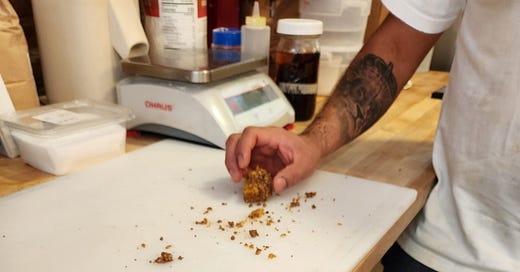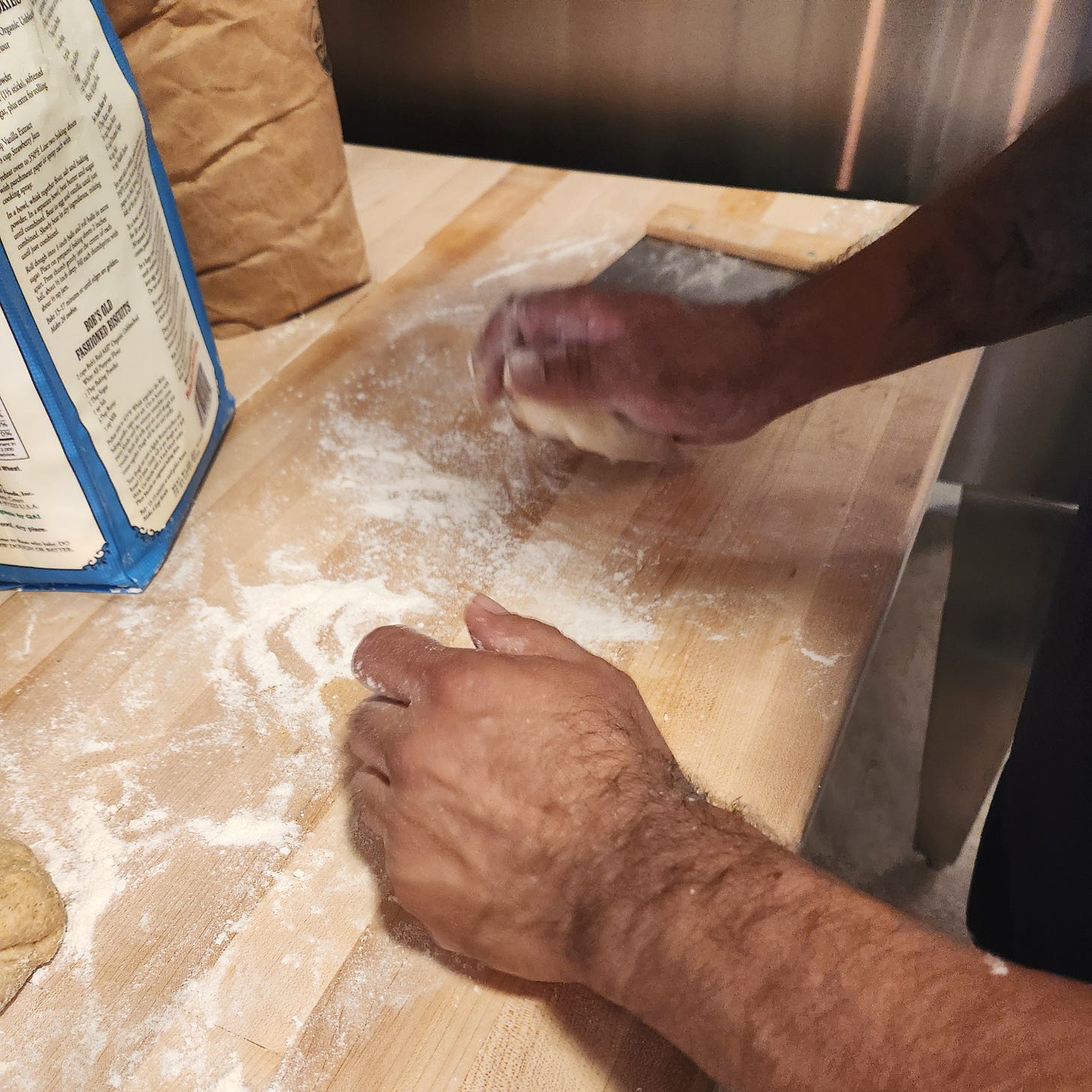As a baker, I find it immensely comforting to know that a robot can never do what I do. In our modern world of super computers, AI, and self-driving cars, the pace of innovation can be a bit disconcerting. But real baking is something that can never be truly modernized, and that’s because it’s an ancient craft which is fully dependent on the human touch.
Of course there are so-called breads and pastries which are made entirely by machine. These factory-produced ultra-processed foods are stuffed full of artificial dough conditioners and preservatives, not to make them better products, but to make them easier for the equipment to handle and the manufacturer to sell. I take an odd comfort in knowing that, after a century of innovation in the mass-produced bread scene – Wonder Bread first went on the market in 1921 – nothing mass-produced has come close to replicating the real loaves of bread and real cookies and cakes made by real people.
The full-inclusion baking movement is another step forward for human innovation, just like the rediscovery of sourdough baking methods was in the ‘80s and ‘90s. That’s because full-inclusion baking, like sourdough baking, is simply harder. There are more variables that need human attention, and the shorter supply chain and increased focus on seasonality makes large machinery obsolete.
A baker has a unique relationship with their breads and pastries. This is for two reasons. First, the baker uses all five senses in the baking process and must be tuned-in with each one. This requires perception, concentration, and presence. Second, the baker is usually the first person to eat the bread or pastry they made. This almost immediate feedback is also perceived by all five senses in the most tangible way. While many artists and artisans must wait for their pottery to be fired or their cheese to ripen, a baker gets one of the quickest forms of gratification, and feedback, in the creative world.
This week we’re discussing how each of the five senses is used in baking, especially full-inclusion baking. Using our senses in a practical way requires intentionality, and for many people this calming and focusing of the mind is a form of meditation. It’s a practice that reaffirms our humanity and grounds us in an ever-changing world.
Touch
As bakers, our hands are our best tools. When we say a Baguette was made by hand, we mean it literally. No other baking tool comes fully equipped with a sense of touch.
Our hands are warm. If we’re working with a laminated dough such croissant dough, our hands will eventually melt the butter. Even basic four-ingredient bread doughs can get overheated if we handle them too much. The founder of the bakery Mauricio and I first worked at used to feel each person’s hands during the interview. Having “cool hands” was an asset, and bakers with “hot hands” needed to learn to shape even faster to minimize their contact with the dough.
Touch is even more important when milling flour. If the flour feels gritty, we need to mill it on a tighter setting. If we can feel a few bran particles but the endosperm is a fine powder, we know we nailed it. When mixing together the dries for a cake batter, using our fingertips to ensure any lumps of spices or cocoa powder have been broken up gives us insurance for the success of our recipe in a way another tool never could.
The downside to using our hands is that we only have one pair which must last us our entire lifetime. If a whisk or a spatula breaks, it’s easy enough to go to the store and buy a new one. That’s not possible with hands. Therefore, it’s important to be thoughtful about how we use them. Professional bakers who shape hundreds of loaves each day know that an unsafe hand position may not hurt now, may not hurt next week, but may be career-ending a few years down the line. Professional bakers are constantly paying attention to how their hands feel, and if one shaping method starts to feel uncomfortable, they’ll change methods for a while. Hands are just that important.
In general, if you need to press, press with your knuckles instead of your fingertips. If you need to really press, use the heel of your hand and rock your entire upper body into the motion. Try to use both your dominate and non-dominate hands equally and build up strength on both sides of your body.
Hearing
Hearing tells us about air content. When checking a loaf of bread for doneness, thump the bottom of it with your thumb. Does it sound hollow? If so, the steam has escaped, the interior structure is set, and the dry air inside of the loaf is echoing, telling you your loaf is perfectly baked.
We can also use our sense of hearing to tell when some loaves are fully proofed and ready to go into the oven. That’s because readiness has to do with two things: gluten relaxation and air content. Hearing gives us insight into the second part. If you hold your four fingers flat together and gently pat your loaf of bread, do you hear a hollow sound? You’ll need to put your ear next to the loaf as the sound will be faint. If the loaf sounds hollow, that means the yeast has done its work. Note that this method does not work with anything sticky!
Sight
Just as hearing gives us insight into the air content of a loaf that’s ready to bake, sight gives us insight into gluten relaxation through the finger-dent test. If you gently press your fingertip about a quarter inch into a loaf of bread, how much does it spring back? A loaf that springs back all the way, refilling the indentation completely, is underproofed and needs more time to ferment and relax. A loaf that does not spring back at all is overproofed. Bake it immediately, and next time, check it earlier. A loaf that springs back about halfway is perfectly proofed. The gluten has relaxed enough that a “blowout” is unlikely, but the loaf will still hold its shape and produce a lovely ear (an “ear” is a raised area of crust) from the oven-spring. Why is the finger-dent test listed under the sense of sight? Well, it’s not about feeling the loaf but rather using your vision to determine how much the loaf springs back.
The sense of sight is most important for judging doneness based on color. If your cake is a medium golden brown around the edge, it’s probably perfectly ready. If your loaf of rye bread is a coffee-colored brown with a thin line of black on the edge of the ear, it’s probably perfectly done. Sight does not replace a thump on the bottom of a loaf or a toothpick inserted in the center of a cake, but it is a valuable piece of information that tells us how far along in the caramelization process our bake is. In a commercial bakery, there isn’t time to thump every loaf of bread to check for doneness. So, we thump the first one, and if it’s done, we know all the loaves that are the same color are done as well.
Smell
Smell tells us when we’re almost done baking something. Breads and pastries will gradually smell stronger and stronger as they bake, and the scent will be the strongest when they’re almost ready. Since I look for the caramel flavor produced by the Maillard Reaction in almost everything I bake, I smell for those caramel notes, and as soon as I detect them, the bake is usually done. Beyond caramelized is burnt, and this has its own smell which I’m sure we all can agree is not pleasant.
Taste
We use our sense of taste when we sample the bread or pastry we just baked. In this way, taste is the sense that checks the performance of all the other senses we used leading up to this point. If we thought our cookies looked like they had taken on enough color, but they’re missing the caramel notes we were looking for, next time we’ll bake them a bit darker.
Taste tells us if the salt content is correct, if something is too sweet or not sweet enough, and if the balance of flavors and spices is what we wanted. Relying on our own taste experience to give ourselves feedback can be a bit daunting. It’s easy to get lost in the thought that someone else might have a different opinion. However, we also must remember that all of our senses, including taste, are subjective. I’ve had the most success when I adjust a recipe to be to my taste without worrying about what others will think. When I present my baked good with the confidence of knowing it’s perfect for me, usually everyone else likes it too.
This week’s recipe is for Wheat and Rye Shortbread. Mixed entirely by hand, and baked until the butter browns and the sugars caramelize, these simple shortbread cookies are a practice in using our senses every step of the way. The simplicity of the recipe allows us to taste each ingredient, and yet they’re so much more than the sum of their parts. Let’s get baking!






